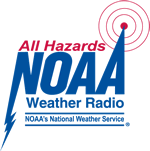How To Set A Weather Radio

...Demand help programing your Weather Radio...
With several brands and models of NOAA Weather condition Radios available to the public for the protection of life and property, there are many different ways to program the differing radios. In an endeavour to get together as many Users Manuals in i place, the NWS Springfield Conditions Radio team has compiled a list of some of the more common radios. For information on how to program your radio, find your brand and model number and click on the link. If y'all do not come across your model number, click on the brand proper noun and you lot will be taken to the manufacturers website. See the Chart at the bottom of the folio for your Make.
Public Alert ™ Devices 
We cannot recommend i make of receiver over some other, only nosotros practice suggest that people look at receivers which comport the Public Alert logo. The Public Alert Standard (CEA-2009-A) was developed by the Consumer Engineering Association in conjunction with the National Conditions Service. Devices which carrying the Public Alert logo run into certain technical standards and come up with many (if not all) of the features mentioned beneath.
Residential Class Radios and Features
Prices can vary from $20 to $200, depending on the model. Many receivers have an alert characteristic, but some may non. Amidst the more useful features in a receiver are:
Tone alarm: The National Conditions Service will transport a 1050 Hz tone alarm before virtually warning and many sentry letters are circulate. The tone will activate all the receivers which are equipped to receive information technology, even if the audio is turned off. This is especially useful for warnings which occur during the nighttime when most people are asleep. (Public Alarm ™ - required)
Same technology: Same, or Specific Alert Message Encoding allows you to specify the particular expanse for which you wish to receive alerts. Most warnings and watches circulate over NOAA Weather Radio are county-based or contained city-based (parish-based in Louisiana), although in a few areas of the state the alerts are issued for portions of counties. Since near NWR transmitters are broadcasting for a number of counties, Aforementioned receivers will respond only to alerts issued for the area (or areas) you have selected. This minimizes the number of "false alarms" for events which might be a few counties away from where you live. (Public Alarm ™ - required)
Selectable alerting of events: While Same allows you to specify a particular area of interest, some receivers let you to turn off alarms for certain events which might not be important to you lot. For example, if you live in a coastal county, but not right at the beach, you might not intendance about Coastal Alluvion Warnings. This feature may likewise be called "Event Blocking" or "Defeat Siren". (Public Alert ™ - optional)
Battery backup: Since ability outages ofttimes occur during storms, having a receiver with bombardment backup can be crucial. Withal, unless you lot have a portable unit which you will use abroad from other power sources, an Air conditioning power connection is recommended to preserve bombardment life. (Public Alert ™ - required for radios, optional for other devices)
External antenna jack: While most receivers come with a whip antenna which can commonly be extended out from the unit of measurement, depending on your location yous may need an external antenna to become a good reception. Some receivers come with an external antenna jack (normally in the back of the unit of measurement) which will let you to connect to a larger antenna (which tin can be indoors or outdoors). Yous tin often purchase these every bit accessories at the same place where y'all bought your receiver, or from most stores with an electronics department. NWR broadcasts are in the Public Service VHF frequencies, just in a higher place FM radio and between the current Tv channels 6 and 7 - so an antenna designed for analog VHF televisions or FM radios should work. Or, you can make your own antenna.
External device jack (special needs) : Some radios have a jack to plug-in external notification devices, such as strobe lights or bed shakers, which can be useful for those with special needs. (Public Alert ™ - required for institutional receivers, optional for consumer receivers).
NOTE: Non all Midland WR-100 Desktop Weather Radios will audibly alert for the routine weekly alert test (Wednesdays between 11am and Noon). Newer models will simply display an LED alert and readout for the Wednesday test.
| Midland Radio | Kickoff Alarm | Oregon Scientific | Radio Shack | HomeSafe, Inc |
| Motorola | Garmin | Sony | Etón USA | C. Crane Company |
| Uniden | ||||
Click here for your county codes
For more data go to our All Hazards Conditions Radio Page
Source: https://www.weather.gov/lot/nwr_programming

0 Response to "How To Set A Weather Radio"
Post a Comment